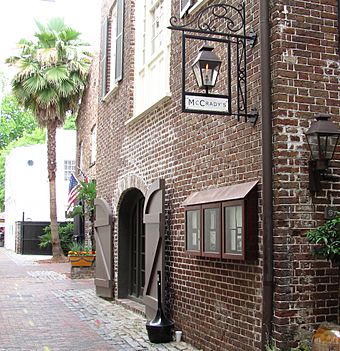McCrady's Tavern and Long Room facts for kids
Quick facts for kids |
|
|
McCrady's Tavern and Long Room
|
|

McCrady's Long Room facade in Unity Alley
|
|
| Location | 153 East Bay Street |
|---|---|
| Nearest city | Charleston, South Carolina |
| Area | .25 acres (1,000 m2) |
| Built | circa 1767–1788 |
| NRHP reference No. | 72001199 |
| Added to NRHP | September 14, 1972 |
McCrady's Tavern and Long Room is a very old building in downtown Charleston, South Carolina. It was built in different parts during the late 1700s. This tavern was a super important place for people to meet and socialize after the American Revolution.
The building's "Long Room," finished in 1788, was special. It was used for plays and big dinners for important people in the city. It's the only room of its kind left in Charleston. McCrady's was added to the National Register of Historic Places in 1982. This means it's important for its history and how it was built.
Edward McCrady (who died in 1794) bought the tavern in 1778. He was a barber, a wine seller, and a tavern owner. He also fought in the Revolutionary War. Over the next ten years, he made the tavern bigger and built the Long Room. In 1791, a group called the Society of the Cincinnati held a big dinner there. George Washington, who was president at the time, attended this special event.
The building kept being a tavern and banquet hall for many years. Later, it became a warehouse and a print shop. In the 1980s, it was fixed up to look like it did in the late 1700s. Today, it is home to McCrady's Restaurant.
Contents
Discover McCrady's Tavern
McCrady's Tavern is made of two main parts. There's the main tavern building, which faces East Bay Street. Then there's the Long Room, which faces Unity Alley.
What Does It Look Like?
The main tavern building is a three-story brick building. It has a flat roof and faces East Bay Street. The building next to it is very close on one side. The back of the building faces a courtyard. This courtyard connects it to the Long Room. The main building goes from east to west. The Long Room goes from north to south. This makes the whole place look like a "T" shape.
The Long Room
The Long Room is a two-story brick building. It is about 75 feet (23 m) long and 25 feet (7.6 m) wide. The front of this building faces Unity Alley. This is a small walking path between East Bay Street and State Street. The main entrance to the whole building is now through a closed-in area next to the Long Room.
The first floor of the Long Room building has an arcade. An arcade is a row of arches. This area was open on the east side. It used to have stalls where horses could stay. The main room for dinners and shows is on the second floor. It used to have a stage and a very tall ceiling, about 16-foot (4.9 m) high. There was also a smaller room and a dressing room for performers.
A Peek into History
The land where McCrady's Tavern stands was first given to a merchant named Jonathan Amory. He sold it in 1723. For many years, the land was used for different businesses. The main tavern building was built by 1767. This is known because it was mentioned in a city survey that year. Edward McCrady bought the building in August 1778. He started using it as a tavern. Like many old taverns, McCrady's offered food and places to sleep. It was also a spot for people to meet and have drinks.
Edward McCrady's Story
During the American Revolution, Edward McCrady was a leader in Charleston's local army. When the British took over Charleston in 1780, McCrady was arrested. He was taken to St. Augustine and held there until 1781. Later, McCrady bought more land next to his tavern. This allowed him to build the Long Room in 1788. The Long Room was used for big dinners and small performances.
George Washington's Visit
On May 4, 1791, something very special happened. The Charleston group of the Society of the Cincinnati held a dinner for President George Washington. This dinner took place in McCrady's Long Room. Other important people were there too. These included the governor of South Carolina, Charles Pinckney, and the mayor of Charleston.
From Tavern to Print Shop
After Edward McCrady passed away in 1794, the tavern had many different owners. In 1884, it was changed into a warehouse. In 1913, a company called Daggett Printing Company bought the building. They used it as a print shop. In the 1970s, the building was empty for several years. Then, it was added to the National Register of Historic Places. Plans were made to fix it up to look like it did in the late 1700s.
McCrady's Today
In the early 1980s, the McCrady building was changed into a restaurant. An architecture company named Bentel & Bentel did the remodeling. The horse stalls under the Long Room were changed. They got new tiles and became a dining area next to the restaurant's bar. The Long Room became a large dining room.
Other changes included adding fancy mahogany wood panels. A beautiful Baccarat crystal chandelier was also added. This is in the room now called the "Chef's Room." In 2010, the restaurant's chef, Sean Brock, won a big cooking award. It was the James Beard Foundation Award for Best Chef Southeast. A food editor from New York Times said McCrady's was one of the best restaurants. It was outside of the biggest cities in America. On April 30, 2020, the restaurant group said McCrady's would stay closed for good. This was after it shut down because of the COVID-19 pandemic.
Images for kids


